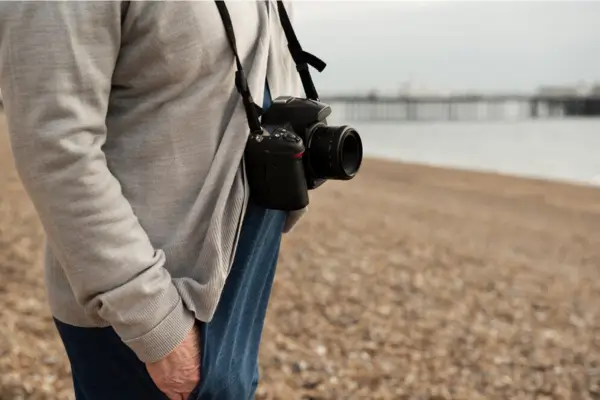Photography is more than just capturing a moment—it’s about telling a story through composition. One of the most fundamental principles that help photographers create visually appealing and balanced images is the Rule of Thirds.
The Rule of Thirds is a simple yet powerful guideline that enhances the way subjects are positioned within a frame. By dividing an image into nine equal parts using two horizontal and two vertical lines, photographers can place key elements at the intersections or along these lines to create a natural sense of harmony and interest.
This technique is widely used in photography, from casual smartphone snapshots to professional-level portraits and landscapes. Whether you are a beginner looking to improve your compositions or an experienced photographer refining your artistic vision, understanding and applying the Rule of Thirds can significantly elevate the quality of your images.
What Is the Rule of Thirds?
The Rule of Thirds is a fundamental compositional guideline in photography that helps create balanced and visually appealing images. It is based on the idea that placing a subject off-center leads to a more dynamic composition compared to simply centering it. This technique is widely used in photography, painting, and design to guide the viewer’s eye naturally through the image.
At its core, the Rule of Thirds divides an image into nine equal parts using two equally spaced horizontal lines and two vertical lines. This forms a grid with four intersection points where the lines cross. Many cameras and smartphone photography apps offer a built-in grid feature to help apply this rule effectively.
To use the Rule of Thirds, photographers should position the most important elements of their composition along these grid lines or at their intersections. For example:
- Placing a subject’s eyes along the top horizontal line in a portrait creates a more engaging and natural look.
- Aligning the horizon with the lower or upper horizontal line in a landscape photo adds depth and balance.
- Positioning a focal point, such as a tree or building, on one of the vertical lines helps create a visually compelling scene.
By following the Rule of Thirds, photographers can avoid static, uninteresting compositions and instead create images that feel balanced, harmonious, and more engaging for the viewer.

Why Is the Rule of Thirds Important in Photography?
The Rule of Thirds is one of the most fundamental principles of photography because it enhances composition, making images more visually appealing and engaging. By strategically placing the subject along the grid’s lines or intersections, photographers create a natural flow that draws the viewer’s eye across the image, resulting in a more dynamic and professional-looking shot.
Creating More Engaging and Dynamic Photos
When a subject is positioned off-center, the composition gains a sense of movement and balance. This subtle shift prevents the image from feeling static or predictable, making it more visually interesting. The Rule of Thirds helps introduce a sense of storytelling within the frame, as the viewer’s eye is naturally guided toward key elements in the image rather than being locked onto a single focal point.
Centered Compositions vs. Rule of Thirds Compositions
While placing a subject in the center of the frame can work in some situations (such as symmetrical compositions or portraits with a strong emphasis on direct eye contact), it often results in a flat and less engaging image. A centered composition can make the subject feel static, lacking a sense of depth or movement.
On the other hand, a Rule of Thirds composition distributes visual weight more effectively. When a subject is placed along the grid lines or at their intersections, it creates balance while allowing the background and surrounding elements to complement the main focal point. This technique often leads to a more aesthetically pleasing and dynamic image that holds the viewer’s interest for longer.
Guiding the Viewer’s Eye Naturally
One of the biggest advantages of the Rule of Thirds is how it naturally directs the viewer’s attention within the frame. When the main subject aligns with the intersection points, the eye is instinctively drawn toward it while still exploring other areas of the image. This flow enhances the overall visual experience, making the photograph feel more immersive and thoughtfully composed.
By using the Rule of Thirds, photographers can transform ordinary shots into captivating images that maintain balance, depth, and movement. Mastering this technique is an essential step toward developing a strong photographic eye and creating compelling compositions.
How to Apply the Rule of Thirds in Your Photography
Mastering the Rule of Thirds can significantly improve your photography composition. By strategically placing elements within your frame, you create more balanced and visually appealing images. Here’s how you can apply this technique effectively:
Using the Grid Feature on Cameras and Smartphones
Most cameras and smartphones have a built-in grid feature that overlays two horizontal and two vertical lines on your screen, dividing the frame into nine equal sections. Enabling this feature helps you position your subjects along the grid lines and intersections, making it easier to apply the Rule of Thirds while composing your shot. To activate it:
- On smartphones, go to your camera settings and look for the “Grid” or “Composition Grid” option.
- On DSLR and mirrorless cameras, check your display settings or shooting menu to enable the grid overlay.
Positioning Key Subjects: Placing the Focal Point on the Intersections
Instead of centering your subject in the frame, try positioning them at one of the four intersection points where the grid lines cross. This placement creates a more natural and engaging composition by drawing the viewer’s eye to the subject while maintaining balance in the scene. Whether photographing a person, an object, or an animal, aligning the focal point with these intersections adds depth and visual interest to your shot.
Framing Landscapes: Aligning the Horizon with the Top or Bottom Third
When capturing landscapes, avoid placing the horizon in the center of the frame, as this can make the composition feel static and less dynamic. Instead:
- Position the horizon along the lower third if the sky is the main point of interest (e.g., during a sunset or when capturing dramatic cloud formations).
- Place the horizon along the upper third if the foreground is more important, such as in beach scenes, fields, or cityscapes.
This technique helps create a sense of balance and guides the viewer’s eye naturally through the image.
Applying the Rule to Portraits: Positioning the Eyes Along the Top Third Line
In portrait photography, the subject’s eyes are usually the focal point of the image. To enhance the composition:
- Align the eyes with the upper horizontal grid line instead of placing them in the center of the frame.
- If the subject is looking to the side, position them on one of the vertical grid lines to create a sense of direction and space.
This approach makes the portrait feel more natural and engaging, helping to establish a stronger connection between the subject and the viewer.
By incorporating these techniques into your photography, you can create more compelling and visually pleasing images. Experiment with different compositions and angles to see how the Rule of Thirds transforms your shots!

When to Break the Rule of Thirds
The Rule of Thirds is one of the most well-known composition techniques in photography, but like any rule, it is meant to be a guideline rather than a strict law. While it often helps create balanced and visually appealing images, there are situations where breaking this rule can lead to even more striking and creative compositions.
When Breaking the Rule Works Best
- Symmetry and Centered Composition
Sometimes, placing the subject in the exact center of the frame creates a sense of harmony and impact. This is especially effective in architecture, reflections, and portrait photography where symmetry plays a key role. Centered compositions can create a strong focal point and a feeling of stability. - Minimalism and Negative Space
Minimalist photography often benefits from breaking the Rule of Thirds. Placing the subject off-center or in an unconventional position within the frame can emphasize negative space, drawing attention to the simplicity and mood of the image. - Leading Lines and Framing
In some cases, leading lines—such as roads, bridges, or pathways—naturally guide the viewer’s eye toward the center of the frame. Similarly, framing techniques that use doorways, windows, or natural elements may look stronger with a centered subject. - Creative Storytelling and Emotion
Photography is about storytelling, and sometimes an unconventional composition helps convey a stronger emotion or message. For example, placing a subject in an unexpected part of the frame can create tension, mystery, or drama that wouldn’t be as impactful with a traditional Rule of Thirds approach.
Experimentation Leads to Personal Style
Breaking the Rule of Thirds intentionally—rather than by accident—requires practice and experimentation. The key is to understand the rule first and then explore when deviating from it enhances your composition. Try taking the same shot using different compositions and compare the results. Over time, you’ll develop a unique photographic style that reflects your artistic vision.
At the end of the day, great photography is not about strictly following rules but about knowing when and how to break them to create powerful and memorable images.
Practical Tips and Exercises
Mastering the Rule of Thirds takes practice, but the good news is that you can improve your composition skills with a few simple exercises. Here are three practical ways to develop a better understanding of this technique:
1. Practice Shooting the Same Subject with and Without the Rule of Thirds
A great way to see the impact of the Rule of Thirds is to take two versions of the same photo—one using the rule and one without it. Try this exercise:
- Choose a subject, such as a person, an object, or a landscape.
- First, take a photo with the subject centered.
- Then, reposition your subject along one of the grid lines or intersections and capture another shot.
- Compare the results and observe how composition changes the overall balance and visual appeal.
This side-by-side comparison will help you understand why off-center compositions often feel more dynamic and engaging.
2. Analyze Famous Photos That Use the Technique Effectively
Studying professional photography is a great way to learn composition. Many iconic images follow the Rule of Thirds to create a compelling visual experience. To try this exercise:
- Look at the works of famous photographers or browse photography websites.
- Pay attention to how subjects are positioned in well-composed images.
- Identify how the use of the Rule of Thirds draws attention to key elements in the frame.
By observing and analyzing great photography, you’ll develop an eye for composition and start recognizing how professionals use the Rule of Thirds to enhance their work.
3. Use Photo Editing Tools to Crop Images Based on the Rule of Thirds
If you have existing photos that don’t follow the Rule of Thirds, you can adjust them in post-processing. Most photo editing software and apps have a built-in grid feature to help with cropping. Here’s how you can use it:
- Open an image in a photo editing program like Adobe Lightroom, Photoshop, or even a mobile app like Snapseed.
- Enable the Rule of Thirds grid overlay.
- Adjust the crop to reposition the main subject along the grid lines or intersections.
- Save the edited version and compare it to the original.
This exercise is particularly useful for understanding how slight adjustments in framing can make a big difference in composition. Over time, you’ll naturally start framing shots more effectively while shooting.
By consistently practicing these exercises, you’ll develop a stronger sense of composition and learn when to apply or break the Rule of Thirds to create visually appealing photographs.

Conclusion
The Rule of Thirds is one of the most fundamental principles of photography, helping photographers create visually compelling and well-balanced images. By positioning key elements along the grid’s lines or intersections, you can naturally guide the viewer’s eye and add depth to your composition. Whether you’re capturing landscapes, portraits, or action shots, this simple yet powerful technique can elevate your photography to the next level.
While mastering the Rule of Thirds is essential, remember that creativity often thrives when rules are intentionally broken. Experimenting with different compositions will help you develop your unique photographic style. The key is to practice consistently—try framing your shots with and without the Rule of Thirds to see how it impacts the final image.
Now, it’s your turn! Have you used the Rule of Thirds in your photography? Share your thoughts and favorite shots in the comments below—we’d love to see your work and discuss different creative approaches! 📸
